Authors:
Spinach Spinach: Head of Research, Ample FinTech
Annabella: zCloak Network CMO
Word count: This research report exceeds 28,000 words and covers a wide range of topics. Please read patiently.
The most eye-catching topic in the blockchain field in 2023 is undoubtedly the tokenization of real-world assets (RWA). This concept has not only sparked discussions in the Web3 world, but also received high attention from numerous traditional financial institutions and government regulatory agencies in many countries, and is seen as a strategic development direction. For example, authoritative financial institutions such as Citibank, JPMorgan, and Boston Consulting Group have successively released their own tokenization research reports and actively promoted related pilot projects.
At the same time, the Hong Kong Monetary Authority explicitly pointed out in its 2023 annual report that tokenization will play a key role in the future of finance in Hong Kong. In addition, the Monetary Authority of Singapore, the Financial Services Agency of Japan, JPMorgan, DBS Bank, and many other financial giants have jointly launched the "Project Guardian" initiative to deeply explore the huge potential of asset tokenization.
Although the topic of RWA is in the limelight, the author has observed that there are divergent views within the industry on the feasibility and prospects of RWA, leading to controversial discussions.
On the one hand, some believe that RWA is nothing more than market speculation and cannot withstand in-depth exploration.
On the other hand, there are also people who are confident in RWA and optimistic about its future.
At the same time, articles analyzing different viewpoints on RWA have emerged one after another.
The author hopes to share a cognitive perspective on RWA in this article and conduct a more in-depth discussion and analysis of the current situation and future of RWA.
Limited to personal knowledge, the content of this article is based on personal opinions. If there are any issues, please feel free to point them out for discussion.
Key points:
- The logic of Crypto's RWA mainly revolves around how to transfer the income rights of income-generating assets (such as income rights of assets such as US Treasury bonds, fixed income, stocks, etc.) to the chain, collateralize off-chain assets to obtain liquidity for on-chain assets, and move various real-world assets to the chain for trading (such as sand, minerals, real estate, gold, etc.), reflecting the unilateral demand of the crypto world for real-world assets, with many obstacles in terms of compliance.
- The future key development direction of Real World Asset Tokenization will be the establishment of a new financial system using DeFi technology on a permissioned chain by traditional financial institutions, regulatory agencies, central banks, and other authoritative institutions. To achieve this system, it requires a computational system (blockchain technology) + non-computational system (such as legal system) + on-chain identity system and privacy protection technology + on-chain legal tender (CBDC, tokenized deposits, legal stablecoins) + complete infrastructure (low-threshold wallets, oracles, cross-chain technology, etc.).
- Blockchain is the first effective technology means to support digital contracts after the development of computers and networks. Therefore, it can be said that blockchain is essentially a platform for digital contracts, and contracts are the basic form of asset expression, while tokens are the digital carriers of assets formed after the formation of contracts. Therefore, blockchain has become the ideal infrastructure for digital assets/tokenized assets, which are the ideal infrastructure for digital assets/tokenized assets.
- As a distributed system maintained by multiple parties, blockchain supports the creation, verification, storage, circulation, execution, and other related operations of digital contracts, solving the problem of trust transfer. And as a "computational system," blockchain can meet the demand of humans for "reproducible processes and verifiable results," so DeFi has become an "computational" innovation in the financial system, replacing the "computational" part of financial activities, automatically executing to achieve cost reduction and efficiency improvement, while also achieving programmability. However, the "non-computational" part, which is based on human cognition, cannot be replaced by blockchain, so the current DeFi system does not cover credit, and uncollateralized lending based on credit has not been achieved in the current DeFi system. The reasons for this phenomenon include the lack of an identity system that expresses "relationship identity" and the lack of a legal system to protect the rights of both parties.
- For the traditional financial system, the significance of Real World Asset Tokenization lies in the digital representation of real-world assets (such as stocks, financial derivatives, currencies, equities, etc.) on the blockchain, extending the benefits of distributed ledger technology to a wide range of asset categories for exchange and settlement.
- Financial institutions further enhance efficiency by adopting DeFi technology, using smart contracts to replace the "computational" aspects of traditional finance, automatically executing various financial transactions according to predetermined rules and conditions, enhancing programmability. This not only reduces labor costs, but also, in specific contexts, it can provide new possibilities for enterprises, especially providing innovative solutions for small and medium-sized enterprises (SMSE) facing financing difficulties, opening a door of great potential for the financial system.
- As the attention and recognition of blockchain and tokenization technology in the traditional financial field and by various governments continue to strengthen, and as the blockchain infrastructure technology continues to improve, blockchain is moving towards integration with the traditional world architecture and solving real-world pain points in practical scenarios, rather than being limited to a "parallel world" separated from the real world.
- In the future, under the pattern of multiple jurisdictions and regulatory systems on permissioned chains, cross-chain technology is particularly important for solving the problems of interoperability and liquidity fragmentation. In the future, tokenized assets on the chain will exist on public blockchains and regulated permissioned chains operated by financial institutions, and through cross-chain protocols similar to CCIP, tokenized assets on any blockchain can be connected to achieve interoperability and achieve universal connectivity.
- Currently, many countries around the world are actively promoting legal and regulatory frameworks related to blockchain. At the same time, blockchain infrastructure, such as wallets, cross-chain protocols, oracles, various middleware, etc., are rapidly being improved, and central bank digital currencies (CBDC) are also continuously being applied. Token standards that can express more complex asset types, such as ERC-3525, are constantly emerging, coupled with the development of privacy protection technology, especially the continuous development of zero-knowledge proof technology, and the increasingly mature on-chain identity system. It seems that we are on the eve of the large-scale application of blockchain technology.
I. Introduction to Asset Tokenization
Asset tokenization refers to the process of expressing assets in the form of tokens on a programmable blockchain platform. Assets that can typically be tokenized include tangible assets (real estate, collectibles, etc.) and intangible assets (financial assets, carbon credits, etc.). This technology, which transfers assets recorded in traditional ledger systems to a shared programmable ledger platform[1], is a disruptive innovation for the traditional financial system and may even impact the entire future financial and monetary system of humanity.
First, the author wants to point out an observed phenomenon: "There are two completely different groups with regard to the understanding of RWA asset tokenization." The author refers to them as Crypto's RWA and TradFi's RWA, and the RWA discussed in this article is from the perspective of TradFi.
RWA from the Crypto Perspective
First, let's talk about Crypto's RWA: The author refers to Crypto's RWA as the unilateral demand of the crypto world for the yield of real-world financial assets. The main background is that in the context of the Federal Reserve's continuous interest rate hikes and balance sheet reduction, high interest rates have significantly affected the valuation of the risk market, and the balance sheet reduction has greatly drained liquidity from the crypto market, leading to a continuous decline in the yield of the DeFi market. At this time, the risk-free yield of around 5% of US Treasury bonds has become a hot commodity in the crypto market, with the most popular being MakerDAO's large-scale purchase of US Treasury bonds this year. As of September 20, 2023, MakerDAO has purchased over $29 billion in US Treasury bonds and other real-world assets.
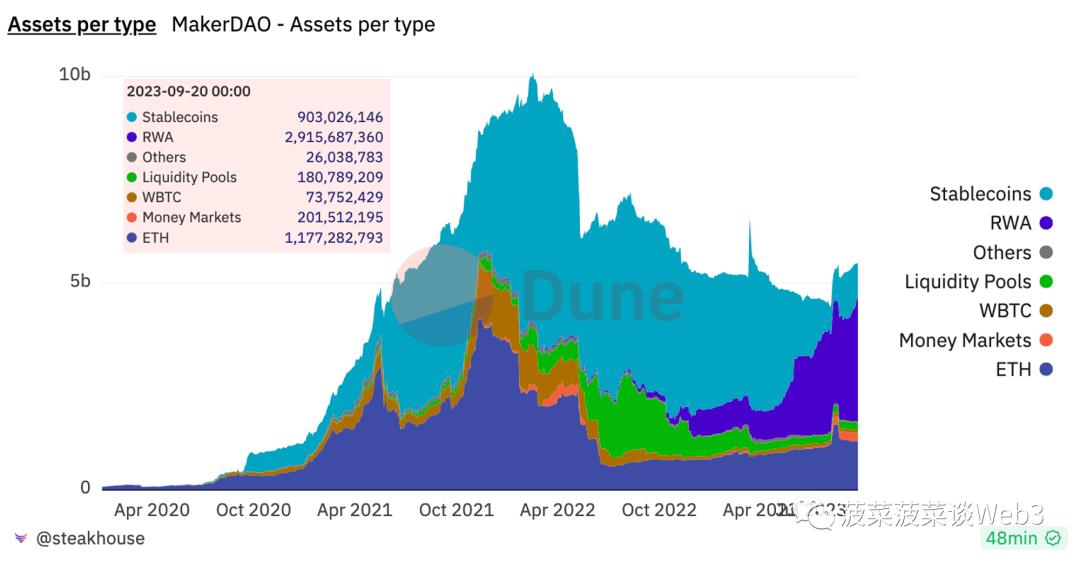
Source: https://dune.com/steakhouse/makerdao
MakerDAO's purchase of US Treasury bonds is significant because DAI can leverage external credit to diversify the assets it supports, and the long-term additional income from US Treasury bonds can help stabilize the DAI exchange rate, increase the flexibility of its issuance, and reduce its reliance on USDC, thus reducing single-point risk[2]. Furthermore, as all income from US bonds flows into MakerDAO's treasury, MakerDAO has recently increased DAI's interest rate to 8% by sharing some of its bond income, thereby increasing the demand for DAI[3].
It is evident that MakerDAO's approach is not something that all projects can replicate. With the skyrocketing price of the MRK token and the market's hype around the RWA concept, various RWA projects have emerged, aside from some large-scale RWA public chain projects that follow compliance. All sorts of RWA concept projects have emerged, with various real-world assets being tokenized and sold on the blockchain, including some rather absurd assets, leading to a mixed bag in the entire RWA race.
In the author's view, the logic of Crypto's RWA mainly revolves around how to transfer the income rights of income-generating assets (such as income rights of assets such as US Treasury bonds, fixed income, stocks, etc.) to the chain, collateralize off-chain assets to obtain liquidity for on-chain assets, and move various real-world assets to the chain for trading (such as sand, minerals, real estate, gold, etc.).
Therefore, we can see that Crypto's RWA reflects the unilateral demand of the crypto world for real-world assets, which still faces many obstacles in terms of compliance. In fact, MakerDAO's approach involves the team using compliant channels for deposits and withdrawals (such as Coinbase, Circle), and purchasing US Treasury bonds through legitimate means to obtain their income, rather than selling this income on the chain. It is worth noting that the so-called RWA US Treasury bonds on the chain are not the US Treasury bonds themselves, but their income rights. This process also involves converting the fiat currency income generated by US Treasury bonds into on-chain assets, adding complexity and friction costs to the operation.
The rapid rise of the RWA concept cannot be solely attributed to MakerDAO. In fact, a research report titled "Money, Tokens, and Games" released by Citibank from the traditional financial sector has also sparked strong reactions in the industry. This report revealed the strong interest of many traditional financial institutions in RWA, while also fueling the enthusiasm of speculators in the market. They have been spreading rumors about major financial institutions joining this field, further raising market expectations and speculative atmosphere.
RWA from the TradFi Perspective
From the perspective of Crypto, RWA mainly represents the unilateral demand of the crypto world for the yield of traditional financial world assets. However, from the perspective of traditional finance (TradFi), the scale of funds in the crypto market is basically negligible compared to the tens of trillions of dollars in the traditional financial market. Whether it is US Treasury bonds or any other financial assets, it is unnecessary to have an additional blockchain sales channel. The visualized market size comparison chart below clearly shows the difference in scale between the crypto market and the traditional financial market.
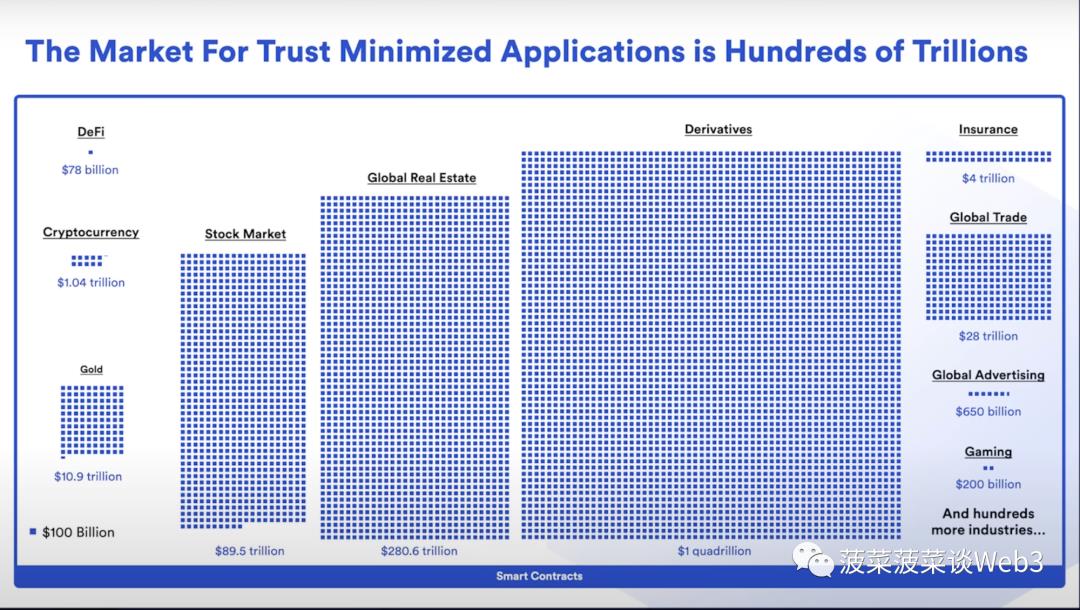
Therefore, from the perspective of traditional finance (TradFi), RWA represents the bidirectional movement between traditional finance and decentralized finance (DeFi). For the traditional financial world, DeFi financial services based on smart contract automation are innovative financial technology tools. RWA in the traditional financial field focuses more on how to combine DeFi technology to achieve asset tokenization, empowering the traditional financial system to reduce costs, improve efficiency, and address the pain points of traditional finance. The focus is on the benefits that tokenization brings to the traditional financial system, rather than just finding a new asset sales channel.
The author believes that it is necessary to differentiate the logic of RWA because the underlying logic and implementation paths of RWA from different perspectives are vastly different. Firstly, in terms of the type of blockchain chosen, the two have different implementation paths. Traditional finance's RWA follows the path of a permissioned chain, while Crypto's RWA is based on a public chain.
Due to the characteristics of public chains, such as no access requirements, decentralization, and anonymity, RWA in the crypto finance world not only faces significant compliance obstacles for project parties, but also lacks legal rights protection for users in the event of adverse events such as rug pulls. Moreover, the prevalence of hacker activities requires a high level of security awareness from users, making public chains potentially unsuitable for the tokenization and trading of a large number of real-world assets.
On the other hand, the permissioned chain on which traditional finance RWA is based provides the basic premise for legal compliance in different countries and regions. At the same time, conducting KYC on the chain to establish an on-chain identity system is a necessary prerequisite for implementing RWA. Under the premise of legal system protection, institutions holding assets can issue/trade tokenized assets in a compliant and legal manner. Unlike Crypto's RWA, the assets issued on a permissioned chain can be native on-chain assets rather than being mapped to existing off-chain assets. The revolutionary potential of these native on-chain financial assets in RWA will be enormous.
In summary, the author believes that the future key development direction of Real World Asset Tokenization will be the establishment of a new financial system using DeFi technology on a permissioned chain, driven by traditional financial institutions, regulatory agencies, and central banks. To achieve this system, it requires a computational system (blockchain technology) + non-computational system (legal system) + on-chain identity system (DID, VC) + on-chain legal tender (CBDC, tokenized deposits, legal stablecoins) + complete infrastructure (low-threshold wallets, oracles, cross-chain technology, etc.).
The following content in this article will start from the first principles of blockchain, leading readers to a detailed explanation of each aspect mentioned by the author and providing practical application cases to support the author's viewpoint.
II. Starting from the First Principles of Blockchain, What Problems Does Blockchain Solve?
Blockchain as the Ideal Infrastructure for Asset Tokenization
Before discussing the first principles of blockchain, we need to have a clear understanding of the essence of blockchain. In the article "What Are Digital Assets?" by Meng Yan, a comprehensive discussion of the definition of digital assets and the essence of blockchain is provided. The article mentions: "As a technology, writing and paper are considered one of the most important inventions of humanity, with immeasurable impact on human civilization. Its influence may exceed the sum of all other technologies." Its application scenarios mainly focus on information dissemination and support for contracts/instructions.
In the application field of information dissemination, through writing, knowledge and information can be replicated, edited, and disseminated at low cost, promoting the widespread transmission of knowledge and the popularization of ideas. In the field of supporting contracts and instructions, writing can also record and convey various instructions. For example, in ancient times, emperors sent military orders and intelligence through documents, bureaucracies conveyed instructions through writing, and commercial activities could form contract records of agreement items through writing, forming consensus and even legal provisions, preserving evidence, and facilitating future regulatory arbitration.
There is a clear difference between these two application scenarios. In the field of information dissemination, people pursue the convenience of low-cost, lossless replication, and editing; while in the transmission of contracts and instructions, authenticity, non-repudiation, and tamper resistance are considered more important attributes. To meet these requirements, people have developed various complex anti-counterfeiting printing technologies, and to this day, handwritten signatures and other verification methods are widely used to ensure the reliability of information.
When the internet emerged and humanity entered the digital age, the internet as a modern information transmission system greatly satisfied the needs of the information dissemination scenario. The internet can achieve the rapid, low-cost, lossless, and convenient transmission of information, providing unprecedented possibilities for the global sharing of knowledge and information. At this time, the transmission and sharing of information became incredibly simple and fast, and both academic knowledge and daily information could be quickly disseminated and shared globally, greatly promoting the progress and development of human society.
However, the internet has encountered difficulties in handling the contract/instruction system, especially in scenarios involving authority and trust, such as enterprise operations, government decision-making, and military command, where the credibility of information becomes crucial. In these situations, relying solely on internet-transmitted information may lead to significant risks and losses due to insufficient credibility. This is because the internet has primarily developed around the first application scenario of information dissemination, emphasizing the rapid, extensive, and convenient transmission of information, often overlooking the authenticity and accuracy of information.
In this context, people have attempted to compensate for this deficiency by relying on centralized decision-making and trusted third parties as the primary means to achieve trustworthy information transmission. However, centralized power structures can lead to the concentration and abuse of power, making information transmission opaque and unfair. The involvement of trusted third parties may also bring about more security risks and trust crises, as the third party itself may become an untrustworthy source of information.
Therefore, the emergence of blockchain technology provides a new solution for handling the contract and instruction system. As a distributed ledger with decentralization, transparency, and immutability, blockchain ensures the authenticity and reliability of information, meaning that people no longer need to rely on centralized institutions or third parties to establish trust. This innovative technology brings a new perspective and approach to the information transmission issues in the contract and instruction system, ensuring the authenticity, integrity, and consistency of information without the need for centralized verification.
If the internet represents the digital upgrade of the writing-paper technology in the information dissemination scenario, then blockchain undoubtedly represents the digital upgrade of the writing-paper technology in the contract/instruction scenario. Therefore, we can identify blockchain as a distributed system maintained by multiple parties, supporting the creation, verification, storage, circulation, execution, and other related operations of digital contracts. It can be said that blockchain is the first effective technological means to support the digitization of contracts after the development of computers and networks. As blockchain is essentially a platform for digital contracts, and contracts are the basic expression form of assets, tokens become the digital carriers of assets formed after the formation of contracts, making blockchain the ideal infrastructure for the digitization and tokenization of assets.
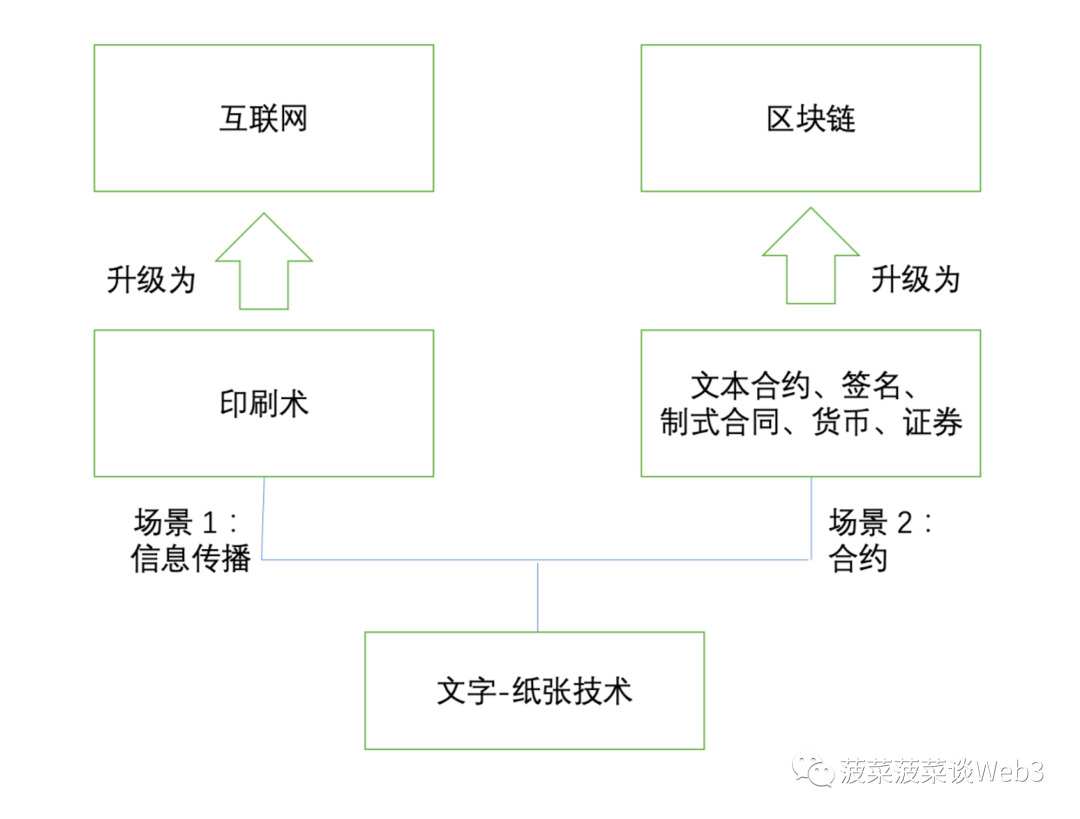
Image Source: https://www.defidaonews.com/article/653729
Blockchain Meets Human Demand for "Computational" Systems
Blockchain provides an infrastructure for the tokenization of assets, and smart contracts are the most basic form of digital asset representation. Ethereum's Turing completeness allows smart contracts to express various types of assets, leading to the creation of standard token types such as fungible tokens (FT), non-fungible tokens (NFT), and semi-fungible tokens (SFT).
Some may wonder why only blockchain can achieve the digital representation of assets. This is because blockchain solves the problem of "computational" systems under the premise of ensuring that it is not manipulated, that is, "the process is repeatable, and the result is verifiable." The author also considers "the process is repeatable, and the result is verifiable" as the first principle of blockchain, as the operation of blockchain is based on this: when a node records a transaction, many other nodes will re-execute the recording process (repeatable process); if the declared result is consistent with the result verified by the node, it will be considered a "fait accompli" in the blockchain world and will be permanently recorded[5].
When we consider what problems blockchain can solve, breaking down the problem into "computational" and "non-computational" systems will help us gain a clearer insight into the essence. Blockchain can solve the problems of "computational" systems, which are based on "the process is repeatable, and the result is verifiable" transactions, while "non-computational" systems include transactions that cannot achieve "the process is repeatable, and the result is verifiable," such as transactions influenced by human cognition. If human cognition, thinking, and judgment are "the process is repeatable, and the result is verifiable," then humans would be nothing more than robots that respond the same way to the same stimulus.
Throughout history, humans have always had a demand for "the process is repeatable, and the result is verifiable" computations. However, due to insufficient technological development, humans could only simulate this "computational" process using physical and cognitive means, such as counting with stones or recording with knots as the most primitive methods. In ancient China, people invented tools such as counting rods and abacuses to meet the growing demand for "computational" processes at that time. However, due to human error, humans could not achieve "the process is repeatable, and the result is verifiable" effectively. With the birth of computers, the "the process is repeatable, and the result is verifiable" process could be solidified in computer programs, and the continuous iteration and upgrade of tools to meet "computational" demands led to a qualitative leap in human productivity, becoming a driving force for the advancement of science, technology, and society.
In a centralized "computational" system like the internet, when human subjective consciousness interferes with this "computational" system, "the process is repeatable, and the result is verifiable" becomes ineffective. For example, hackers can manipulate programs to produce different output results, affecting the reliability and authenticity of information transmission, hindering the transfer and construction of trust.
With the birth of blockchain, a new tool that satisfies "computational" demands emerged. When the decentralized nature of blockchain is achieved, human subjective consciousness becomes less able to interfere with this computational system. For example, if a hacker wants to manipulate the output of a smart contract, they may need to control more than 50% of the nodes in the blockchain to achieve this, and such attacks often do not have a cost-benefit ratio. Therefore, in non-extreme situations, blockchain can effectively meet human demands for "computational" systems.
DeFi is a "Computational" Financial Innovation
Since the emergence of Ethereum and smart contracts, blockchain has occupied a pivotal position in the financial field due to its inherent financial attributes, making finance one of its most important application scenarios. As a result, decentralized finance (DeFi) has emerged as the most widely used scenario in the blockchain field.
DeFi is a new financial model that provides various financial services, such as lending, investment, or exchange of crypto assets, relying on distributed ledger technology without the need for traditional centralized financial institutions. DeFi protocols implement these financial services using a set of smart contracts, which are programs that automatically execute the logic of traditional financial operations. Therefore, DeFi users interact with programs that can aggregate the assets of other DeFi users to maintain control over their funds, rather than interacting with another party during transactions[6].
As a "computational" system, we can view DeFi, composed of smart contracts, as an innovation in the "computational" aspect of finance. Smart contracts can replace some "computational" aspects in traditional finance, such as repetitive steps in financial activities that rely on human or mechanical processes to "obtain a deterministic result through repeating a process," such as clearing, settlement, transfers, and some repetitive work that does not rely on human cognition. In short, DeFi can automate the time-consuming steps in traditional financial activities that require human involvement, significantly reducing transaction costs, eliminating settlement delays, and achieving automated execution and programmability.
The concept corresponding to "computational" systems is "non-computational" systems, which is human cognition. Blockchain is a purely "computational" system that can only solve computational problems and cannot solve problems at the cognitive level. The cognitive system corresponds to the credit system in the financial system, such as credit assessment and risk control systems in credit, where different banks may make different judgments on the specific credit limit for the same customer, despite having the same work income and bank transactions.
For example, the same customer may receive a credit limit of $10,000 from one bank and $20,000 from another. This difference is not based on a repeatable and verifiable computational process but is deeply influenced by human cognition, experience, and subjective judgment. Each bank has its own risk control system, but in specific credit decisions, human cognitive factors still play a decisive role. These cognitive decisions have the characteristics of being non-repeatable and not fully verifiable because they integrate human subjectivity and interpretations of non-black-and-white issues.
Or is it possible to solve the problem of defaulting on debts by putting debt contracts on the chain and automating the repayment process? To explore this issue, we first need to analyze the nature of debt itself. Debt is not just a contract or a form; it is a relationship built on mutual cognition and trust between people. Essentially, the establishment of a debt relationship does not solely rely on the formation of a contract; it depends more on human cognition.
Blockchain technology can put the "essence" of debt contracts on the chain and set rules for the contracts through programming to achieve the automation of repayment processes and debt transfers. This process is predictable and verifiable because it relies on fixed rules to ensure "the repeatability of the process and the verifiability of the result." However, the operation of this system does not involve the cognitive aspect of humans.
Although the "essence" of debt contracts has been objectively confirmed and guaranteed by technology, the formation, modification, and termination of debt relationships are based on human cognition. This cognition cannot be programmed or put on the chain. Human cognition is not a "repeatable, verifiable" process; it may change with the environment, emotions, and information. When a debtor's cognition changes, they may choose not to fulfill their debt, known as "defaulting." Therefore, putting it on the chain cannot solve the problem of defaulting, as this is a cognitive issue rather than a computational one.
Some may ask, isn't the lending protocol in DeFi able to solve the problem of borrowers defaulting through smart contract liquidation? Isn't lending behavior on DeFi a form of credit system? Jake Chervisnky, the legal counsel of Compound, once published an article arguing that DeFi lending protocols do not actually involve lending, but are interest rate agreements[7]. In simple terms, DeFi lending does not generate any credit. Most DeFi lending protocols rely on the same basic mechanisms to function: over-collateralization and liquidation. In other words, borrowers need to collateralize assets exceeding the loan amount, such as collateralizing $100 worth of ETH to borrow $65 worth of USDT. This type of lending is essentially a form of "computational leverage" and does not generate any credit. Borrowers do not rely on any commitments of future payments, trust, or reputation.
In summary, blockchain, as a distributed system maintained by multiple parties, supports the creation, verification, storage, circulation, and execution of digital contracts and other related operations, solving the problem of trust transfer. As a "computational" system, blockchain can meet human demands for "the repeatability of the process and the verifiability of the result." Therefore, DeFi has become an innovation in the financial system's "computational" aspect, replacing certain "computational" aspects in traditional finance with smart contracts, achieving automated execution, reducing costs, and enhancing programmability. However, blockchain cannot replace the "non-computational" aspect based on human cognition. Therefore, the current DeFi system does not cover credit, and unsecured lending based on credit has not been achieved in the current DeFi system. The reasons for this include the lack of an identity system to express "relationship identity" and the absence of a legal system to protect the rights of both parties.
III. How Does Asset Tokenization Subvert Traditional Finance?
Financial services are based on trust and empowered by information. This trust relies on financial intermediaries that maintain and verify the accuracy and integrity of financial data, covering ownership, liabilities, conditions, and contracts, which are usually dispersed across independently operated systems or ledgers. These institutions maintain and verify financial data, enabling people to trust the accuracy and integrity of this data.
Because each intermediary holds different pieces of the puzzle, the financial system requires a significant amount of post-coordination for reconciliation and settlement of transactions to ensure the consistency of all related financial data. This is an extremely complex and time-consuming process. For example, in the context of cross-border transactions, due to the need to comply with different regulations and standards in various countries, and involving multiple different financial institutions and platforms, this process is particularly complex, often resulting in a long settlement cycle, typically taking one to four days to settle, increasing transaction costs and reducing transaction efficiency[8].
Blockchain, as a distributed ledger technology, has shown tremendous potential in addressing the efficiency issues prevalent in traditional financial systems. By providing a unified, shared ledger, it directly addresses the problem of information fragmentation caused by multiple independent ledgers, greatly enhancing the transparency, consistency, and real-time updating capability of information. The application of smart contracts further enhances this advantage, allowing transaction conditions and contracts to be encoded and automatically executed when specific conditions are met, significantly improving transaction efficiency and reducing settlement time and costs, especially in complex multi-party or cross-border transaction scenarios.
Therefore, asset tokenization is increasingly being accepted by traditional finance. According to a survey report by the Bank of New York Mellon, 97% of the 271 financial institutions interviewed believe that tokenization will bring about a new revolution in asset management[9], fully demonstrating the potential of blockchain in the financial field.
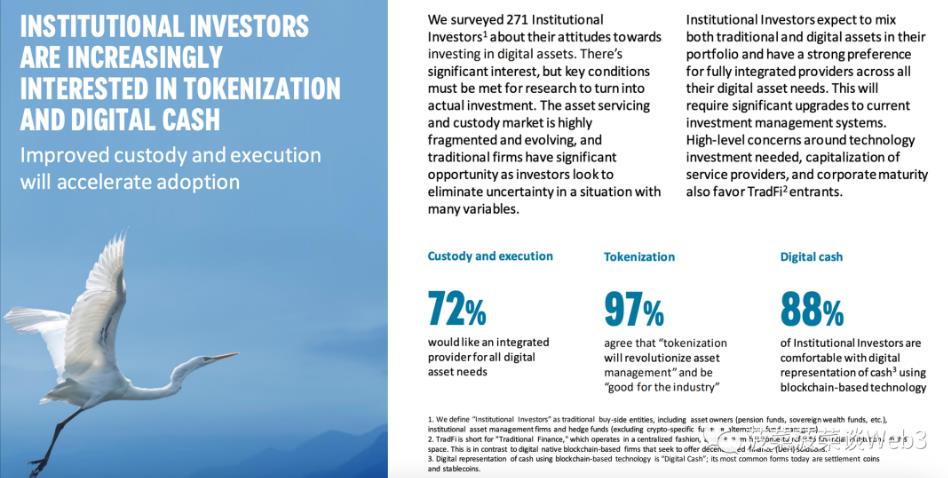
Image Source:
https://www.bnymellon.com/content/dam/bnymellon/documents/pdf/insights/migration-digital-assets-survey.pdf
Therefore, for the traditional financial system, the significance of Real World Asset Tokenization lies in creating digital representations of real-world assets (such as stocks, financial derivatives, currencies, equities, etc.) on the blockchain, extending the benefits of distributed ledger technology to a wide range of asset categories for exchange and settlement.
Financial institutions further improve efficiency by adopting DeFi technology, using smart contracts to replace the "computational" aspects of traditional finance, automatically executing various financial transactions according to predetermined rules and conditions, enhancing programmability. This not only reduces labor costs but also, in specific contexts, can provide new possibilities for enterprises, especially providing innovative solutions for the financing difficulties of small and medium-sized enterprises (SMEs), opening a door to great potential for the financial system.
To further explore the potential transformative power of tokenization on the financial system, this article will present a more in-depth analytical framework:
Establishing a Trusted Global Payment Platform, Lowering Costs and Increasing Efficiency
Clearing and settlement are ubiquitous in various aspects of human daily life, financial activities, and trade, becoming a key link in maintaining economic flow. Although these two processes are very common in daily life, they are often not the focus of the general public, yet they are the driving force behind ensuring smooth transactions.
In our daily activities such as shopping, paying wages, and splitting bills, there are processes of clearing and settlement involved. Even when we split expenses with friends, we are engaging in a simplified process of clearing and settlement—calculating each person's share and making transfers. Similarly, when we use Alipay or WeChat for electronic payments, the payment platform goes through a series of clearing processes to ensure that the payment amount is accurately and correctly transferred from our account to the merchant's account. For users, it's just a simple payment action, but behind this simple payment action, there are many clearing and settlement processes involved (as shown in the figure below[10]).
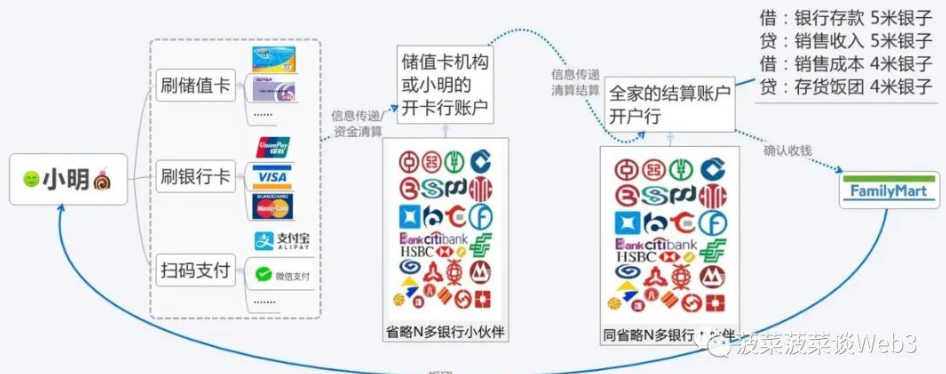
Image Source: https://www.woshipm.com/pd/654045.html
According to the Committee on Payment and Settlement Systems (CPSS) definition of clearing and settlement, CPSS defines a clearing system as a set of arrangements that enables financial institutions to submit and exchange data and documents related to the transfer of funds or securities. It all starts with establishing a "net position" for the transaction participants, offsetting the debts of both parties, a step called "netting"[11].
Subsequent clearing refers to the process of exchanging, negotiating, and confirming payment instructions or security transfer instructions, which occurs before settlement. Settlement refers to the process of the seller transferring securities or other financial instruments to the buyer, and the buyer transferring funds to the seller, which is the final step of the entire transaction. The settlement system ensures the smooth transfer of funds and financial instruments.
In simple terms, clearing involves the sending, receiving, verifying, and reaching a final consensus on the pending payment assets, while settlement involves asset transfer based on the clearing results. Let's explain this process through an example:
Clearing
Imagine you and your friends decide to split the bill after having dinner at a restaurant. Everyone declares their individual expenses, and then collectively calculates the amount each person should pay. In this scenario:
- Amount Determination: Each friend's declared expense is similar to a payment instruction.
- Communication and Verification: Everyone reports their expenses to each other and verifies the total amount, which is equivalent to the steps of sending, receiving, and confirming payment instructions in clearing.
- Total Calculation: After calculating the total bill, the amount each person should bear is determined, which is equivalent to exchanging payment information and confirming the final pending position (i.e., the amount each person should pay).
Therefore, clearing is a "verification and preparation" step where parties confirm the pending payment amount and prepare for the next step of settlement.
Settlement
In the example, once everyone knows the amount they need to pay, the next step is to make the actual payment. Everyone pays their respective share, and the total amount covers the restaurant bill. At this point:
- Payment: The amount each person actually pays is similar to the step of fund transfer.
- Verification: Everyone confirms whether their payment is accurate and verifies if each member has paid the correct amount, similar to the step of confirming the correct transfer of funds during settlement.
- Notification: If one friend is responsible for collecting all the payments and paying the bill at once, they would notify others once the payment is completed. This notification step is similar to informing all parties after settlement is completed.
Therefore, settlement refers to the actual transfer of funds from one party to another and confirming the completion of the transaction.
It is evident that in the traditional financial system, clearing and settlement involve a "computational" process of verification and confirmation. Parties reach consensus through continuous verification and validation, and then proceed with asset transfers based on this consensus. This process requires collaboration among multiple financial departments and significant labor costs, and may also face the risk of operational errors and credit risks.
On June 28, 1974, a notable bank bankruptcy event drew widespread attention in the international financial community, namely the collapse of Herstatt Bank, exposing the cross-border payment credit risk and its potential massive destructive power. On that day, several German banks conducted a series of German Mark to US Dollar foreign exchange transactions with the aim of remitting dollars to New York, with Herstatt Bank as the counterparty.
However, due to the time difference between Germany and the United States, the transaction settlement process encountered significant delays. This time difference resulted in the dollars not being transferred to the counterparty bank's account in New York immediately, but being "held" in Herstatt Bank. In short, the expected dollar payments were not implemented as planned. During those critical hours, Herstatt Bank received a settlement order from the German authorities.
Due to the lack of payment capability, it failed to remit the corresponding dollar funds to New York, ultimately leading to its bankruptcy. The ripple effects of this sudden bankruptcy event caused varying degrees of losses to several German and American banks engaged in foreign exchange transactions. The occurrence of this event also prompted the widespread application of real-time gross settlement systems in the field of cross-border payments and the establishment of the Basel Committee on Banking Supervision[12], highlighting the importance of settlement and clearing in the international financial market.
With the innovative collaboration of the Bank for International Settlements Innovation Hub (BISIH), the Bank of France, the Monetary Authority of Singapore (MAS), and the Swiss National Bank, the Mariana Project (Projeto Mariana) released a test report on September 28, 2023, successfully verifying the technical feasibility of using automated market makers (AMMs) for international cross-border transactions and settlement of tokenized central bank digital currencies (CBDCs)[14].
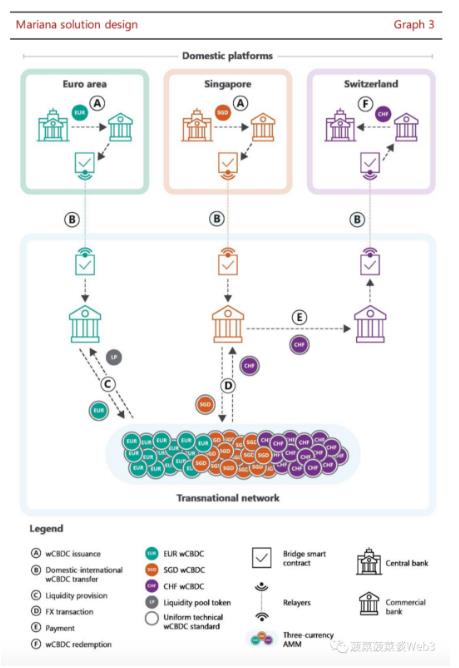
Image Source: https://www.bis.org/publ/othp75.htm
In summary, payment behavior in the traditional financial system is often accompanied by cumbersome clearing and settlement processes, resulting in additional costs, inefficiencies due to settlement delays, as well as facing issues such as human errors, credit risks, and strict time window constraints. However, the use of blockchain and DeFi technology provides an effective solution.
By integrating blockchain technology, the transaction process is optimized, and intermediate steps are reduced, significantly lowering related costs. This technology avoids the long waiting time for traditional financial settlement, achieving true round-the-clock market operations, especially greatly improving processing speed and accuracy in cross-border payments. More importantly, with the reduction in transaction costs, the indirect increase in profits may far exceed direct cost savings, thereby promoting the vitality and efficiency of the financial market on a broader scale.
Programmability and Transparency
For the traditional financial system, the programmability and transparency of real-world asset tokenization will bring disruptive changes. We can use financial derivatives as an example to illustrate the disruptive impact of programmability and transparency. Financial derivatives in the traditional financial market constitute a massive market, with an estimated nominal value exceeding hundreds of billions of dollars[15]. The derivatives market encompasses a wide and complex range of contracts, including stocks, fixed income, foreign exchange, credit, interest rates, commodities, and other types of contracts in different markets. These types of contracts include options (ordinary call and put options, as well as exotic options), warrants, futures, forwards, and swaps.
It is the enormous potential of leverage in financial derivatives that allows them to create asset sizes far exceeding the underlying asset value. The 2008 financial crisis is a classic case triggered by financial derivatives, where banks packaged a series of mortgages to create a special financial product—Mortgage-Backed Securities (MBS) and sold them to investors. For banks, this approach could transfer the original loan risk, generate cash flow by selling these packaged mortgages, and earn a spread. For banks, the issuance of each loan almost became a creation of profit, resulting in significant risk.
The movie "The Big Short" vividly illustrates this phenomenon: when each housing loan means a profit and the risk is no longer associated with the bank, banks tend to endlessly create mortgage contracts. When creditworthy homebuyers are exhausted, banks tend to seek other individuals with poor credit to continue this game, even a person with no collateral can obtain a loan from the bank in the name of their dog. These low-quality "subprime loans[16]" became the catalyst for the subsequent financial tsunami.
In the backdrop of continuous rise in U.S. real estate prices and loose monetary policy with low interest rates, banks kept issuing subprime loans, and Wall Street financial institutions invented various financial derivatives, such as Collateralized Debt Obligations (CDOs), which are financial instruments that package various MBS; and synthetic CDOs, which package various CDOs and Credit Default Swaps (CDS).
As a result, a myriad of complex financial derivatives emerged in the market, making it impossible for people to track the underlying assets supporting these products. With a large number of subprime loans mixed into "low-risk" financial derivatives due to distorted ratings, high-risk assets only required paying extremely low premiums. These layered and packaged derivatives were sold to various brokers and investors, rapidly increasing the leverage ratio of the entire financial system and making it extremely vulnerable.
Subsequently, the U.S. began raising interest rates, leading to a large number of borrowers defaulting due to increased loan interest. This problem first surfaced in the subprime loan market, but because subprime loans were packaged in Asset-Backed Securities (ABS), MBS, and even CDOs, this issue quickly spread throughout the entire financial market. Many seemingly high-grade, low-risk financial derivatives suddenly revealed significant default risks, and investors were almost unaware of the actual risks of these derivatives. Market confidence was severely shaken, leading to massive sell-offs in the financial market, becoming a significant trigger for the 2008 financial crisis. All of this stemmed from the chaos, opacity, and overly complex structure of the financial market.
It is evident how important transparency is for complex financial derivatives. If tokenization technology had been used before 2008, investors could easily have penetrated and understood the underlying assets, perhaps preventing such a financial crisis. Furthermore, tokenizing financial derivatives can also improve the efficiency of multiple stages in the asset securitization process, such as servicing, financing, and structuring (i.e., tranching)[17].
For example, using the semi-fungible token standard ERC-3525 to package assets in the asset securitization process. The digital container feature of ERC-3525 can package non-standard assets into a standard asset that can be split, using smart contracts to layer them (senior, mezzanine, junior), and programmatically manage the cash flow of the assets, reducing operational and third-party costs, greatly enhancing asset transparency and settlement certainty.
When using blockchain, the monitoring role of regulatory agencies can be partially assumed by the platform. When key information, such as documents submitted by the seller, past records, and updates, is visible to all key stakeholders on the blockchain platform, single-party governance effectively becomes multi-party governance. This means that any party has the right to analyze data and detect anomalies, and this timely information disclosure can reduce transaction costs in the financial market[17].
To further understand the benefits of programmability and transparency brought to the traditional financial system, the "digital invoice tokenization" project based on ERC-3525 by the Australian startup Unizon, selected for the Australian central bank's CBDC pilot project, is an excellent example[18]. In supply chain finance, accounts receivable factoring is a common business model. It allows companies to sell accounts receivable at a discounted price to a third party (usually a factoring company) to obtain necessary financing and improve their cash flow.
However, due to the difficulty of verifying invoices, small and medium-sized enterprises generally lack sufficient credit support, and investors cannot reasonably control a large number of small and medium-sized enterprises. This results in widespread financing difficulties for small and medium-sized enterprises. If small and medium-sized enterprises cannot accept delayed payments, it is difficult for them to receive orders from large enterprises. However, accepting orders from large enterprises can lead to a shortage of working capital and increase the risk of cash flow disruption for the company.
By tokenizing invoices, we can use a confirmation step in the invoicing process through private key signatures. Once confirmed, the invoice will be generated and accompanied by the confirmation signatures of both parties, ensuring that the invoice is generated in a state confirmed by both parties. Considering that delayed payment is actually equivalent to a form of loan provided by the seller to the buyer, if the problem of invoice authenticity can be effectively solved, the seller can sell the accounts receivable to a factoring institution at a discounted rate based on the buyer's credit, thereby obtaining discounted funds.
Benefiting from the programmable capability of cash flows using ERC-3525 in the "digital invoice tokenization" scenario, payment invoices are tokenized. A pair of accounts is created using ERC-3525: a payable account and a receivable account. These two accounts form a payment channel similar to entangled quantum entanglement, where funds are automatically distributed to the receivable account through smart contracts as long as the buyer remits funds to the payable account. This means that regardless of how many portions the accounts receivable are split into and no matter who ultimately receives them, they will be transferred to the receivable account according to the predetermined ratio. This is an operation that is extremely costly and difficult to achieve in the traditional financial system, and tokenization technology greatly increases the liquidity and composability of the supply chain finance factoring business, while reducing operational costs.
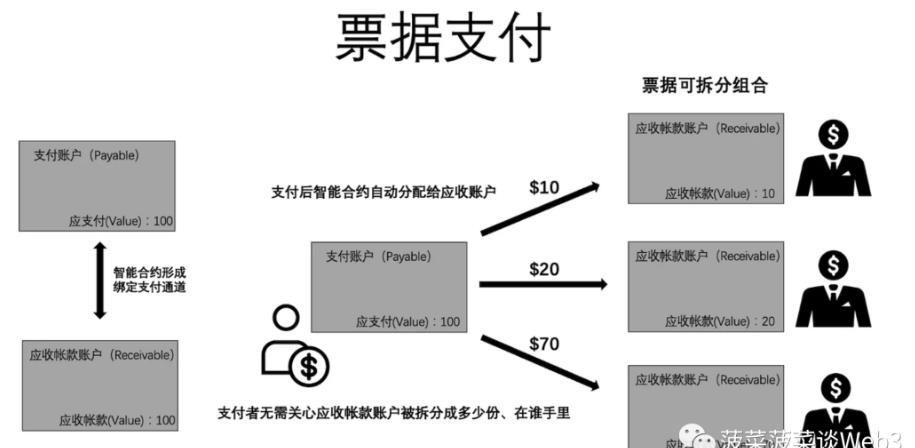
Image Source: https://mirror.xyz/bocaibocai.eth/q3s_DhjFj6DETb5xX1NRirr7St1e2xha6uG9x3V2D-A
In summary, the programmability and transparency of tokenization have a tremendous impact on the traditional financial system. The transparency brought by blockchain platforms not only reduces financial risks and information asymmetry in the traditional financial system but also opens the door to many operations that were difficult to achieve in the traditional financial system, greatly reducing the cost of human intervention and third-party involvement. This not only greatly enhances the liquidity and composability of financial services but also creates space for innovation, potentially giving birth to unprecedented types of financial products.
IV. What Else Is Needed for Mass Adoption of Asset Tokenization?
Tokenization undoubtedly brings revolutionary innovation to the traditional financial system, but to truly apply this innovation to real-world scenarios, we still face many challenges and difficulties. The following are some key factors to consider for achieving mass adoption of asset tokenization:
Sound Legal System Guarantees and Permissioned Chains
Blockchain, as a purely "computational system," can only address people's demands for "computational" matters (reducing friction costs, programmability, traceability, etc.), while demands for relationship rights, judgment of right and wrong, and protection of rights require a cognitive non-computational system, such as a sound legal regulatory system. Because the legal and regulatory system cannot rely on a fixed set of procedures for execution, judgment, and control of risks, it is based on human cognition, which is a demand that public blockchains cannot meet. Not to mention the rampant hacking and frequent security incidents in the public chain ecosystem, when a user's wallet is stolen on the public chain, the assets are almost impossible to recover and there is no way to protect their rights. The open and anonymous nature of public chains also makes it difficult to enforce regulation and law.
Real-world asset tokenization in the traditional financial field involves a large number of asset issuance and trading operations. For financial institutions that hold core assets, compliance and security are the main demands. Imagine if a financial institution issued tokenized financial assets worth several hundred million dollars on a public chain, only to have all the assets stolen by a North Korean hacker organization. In this scenario, it is impossible to recover the lost assets or legally sanction the criminals, which is clearly unacceptable.
Therefore, the financial industry needs to rely on a series of legal safeguards to protect investors from fraud and abuse, combat financial crimes and cybercrimes, safeguard investor privacy, ensure that industry participants meet certain minimum standards, and provide recourse mechanisms in case of problems. Therefore, only permissioned chains can simultaneously meet the demands for "computational" and "non-computational" matters. We can imagine that in the future, each country or region will have different legal and regulatory systems, and each region will have a permissioned chain that complies with the legal and regulatory system of that region to carry out real-world asset tokenization.
Identity System and Privacy Protection
Relationship-based identity vs. contract-based identity
If blockchain hopes to closely integrate with the real world and achieve mass adoption, a complete on-chain identity system is crucial. For a long time, blockchain has been difficult to reveal the true identity of wallet holders due to its anonymity, and a system lacking identity authentication naturally struggles to establish trust. However, trust is a product of human social cognition, relying on deep social connections between individuals. In fact, the blockchain world has always lacked a "relationship-based identity" system. This system is not just a simple identity label, but a complex structure that reflects an individual's various roles and relationships in the social network.
More than 150 years ago, the ancient British legal scholar Henry Maine inspired people to think deeply about the nature of identity[30]. He proposed two major categories of identity: one is "relationship-based identity," which originates from an individual's roles and interpersonal relationships in society, such as being a father, holding a certain nationality, or having an identity as a civil servant, soldier, etc. This type of identity is a reflection of social attributes, emphasizing an individual's position in the social structure and their connections with others.
The other type of identity is the "contract-based identity" system based on "contract execution," such as labor agreements, company organizational structures, and contract terms. In the blockchain field, this can be likened to the "identity" attributes formed by interactions of smart contracts, such as wallet balances, interaction history with smart contracts, and states generated by smart contracts.
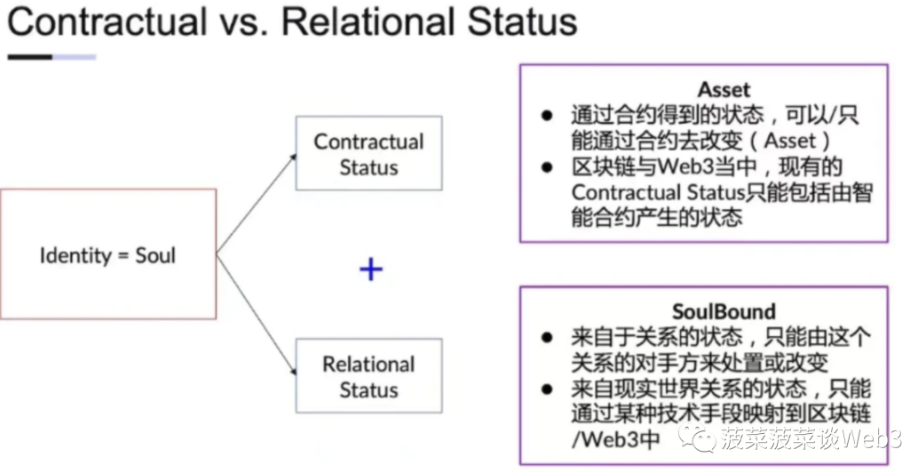
Image Source: Supporting the Pillars of "Web3 III": Information, Contracts, Identity, "Centralization" is Still Indispensable
For many years, blockchain has fundamentally been a purely "computational system," where only "contract-based identity" exists. Specifically, the on-chain information is limited to non-real-name wallet addresses, their balances, transaction history, and other data. Although people have tried to use these data elements to construct a "relationship-based identity" system on the chain, the contract-based identity system lacks the ability to express social relationships, and it cannot fully capture or replicate the social dimensions and human interactions covered by "relationship-based identity."
This limitation is a significant factor hindering the development of the blockchain field, especially decentralized finance (DeFi), such as the lack of a credit-based unsecured lending system. Purely contract-based identity authentication cannot capture an individual's reputation and trust, because credit is built on complex human social relationships, not just the historical records of smart contracts or account balances. To achieve such a credit system, what is needed is not just a technical solution, but also a mechanism that can understand and reflect the complex network of human social relationships.
Currently, the state of the identity system in the blockchain world is far from meeting the conditions required for the mass application of real-world asset tokenization. In addition to the "contract-based identity" system, blockchain also needs a "relationship-based identity" system that can carry human social relationships and a credit system, because in human society, credit is built on deep, multidimensional social interactions. It is not an attribute that individuals can unilaterally assign to themselves, but is shaped by an individual's behavior, reputation, and recognition by others in the social network. More importantly, such a credit system often requires authoritative third-party institutions to certify and endorse it to ensure its credibility and authority. For example, in the real world, identity documents and related documents issued by governments or other authoritative institutions are important indicators of an individual's identity and reputation.
In summary, for blockchain to achieve mass adoption and integration with the real world, it needs to combine a "relationship-based identity" system with a "contract-based identity" system. To achieve a "relationship-based identity" system, it is necessary to introduce authoritative third parties (such as government agencies, regulatory agencies, etc.) to assign, certify, and endorse on-chain identities based on individual social relationships and reputation. At the same time, technological innovation is also needed to ensure the security, privacy, and tamper resistance of identity data.
W3C Standard DID+VC Identity System
For the mass application and realization of real-world asset tokenization, a comprehensive identity solution is urgently needed on the technical level to achieve a dynamic balance between data sovereignty, privacy protection, regulatory compliance, and interoperability. The DID+VC system under the W3C standard may be part of the solution to this unresolved issue.
In the development of digital identity, we have witnessed several important stages of transformation: from centralized identity management, where identity information is completely controlled by a single authority; to federated identity authentication, which allows users' identity data to be somewhat portable and enables cross-platform logins, such as one-click logins through WeChat or Google accounts; then to decentralized identity systems based on authorization and permission, as demonstrated by OpenID; and finally to self-sovereign identity (SSI), where ownership and control of data truly return to the individual, although this mechanism, such as the zkID decentralized identity system introduced by zCloak Network, has not been widely adopted.
Currently, the on-chain identity system has enhanced the anonymity and openness of identity to a certain extent through the use of cryptographic mechanisms built into the blockchain. However, because different ecosystems and application systems often use closed or relatively independent data systems, users' identity information is still fragmented and stored in isolated and difficult-to-interoperate systems. Therefore, the next key challenge is to break down these silos and build an identity verification ecosystem that not only ensures individual data sovereignty and privacy but also meets regulatory requirements and has broad interoperability. This requires not only technological innovation but also deep cooperation among stakeholders and support from policymakers.
The World Wide Web Consortium (W3C), responsible for developing international internet standards such as HTML and CSS, launched the first formal standard for Decentralized Identifiers (DID) in 2022, and in 2019 released a detailed definition and standard framework for Verifiable Credentials (VC).
In the W3C specification, DID is defined as a globally unique, highly available, resolvable, and cryptographically verifiable string (e.g., did:example:123). This identifier can be used to identify any form of entity, whether it is an individual, organization, or object. Each DID is generated according to a specific algorithm and is independently controlled by its owner, rather than authorized by a single institution.
DID can be resolved to a DID document, which contains authorization keys, protocol keys, delegation keys, assertion keys, and service endpoints for interacting with DID entities. These keys are similar to different types of documents used for signing in different life scenarios, such as confidentiality agreements, delegations, or authorizations.
VC, the verifiable digital credential that complements DID, is actually an endorsement-style declaration issued from one DID to another DID, aimed at verifying the identity, capabilities, or qualifications of the DID subject. For example, VC can be a digital certificate issued by an organization, government department, or commercial entity, generated and verified through cryptographic methods to confirm that the owner possesses certain specific attributes, and these attributes are trustworthy. VC can contain various information and data types, such as ID, type, timestamp, etc., and support multiple settings for the status of the credential, including valid, expired, revoked, frozen, etc., to reflect the issuer's declaration of the credential's validity.
In the VC ecosystem, the W3C standard defines three roles: issuer/attester, holder/claimer, and verifier. These roles collectively participate in the circulation of a credential: the issuer verifies and issues the credential to the holder, the holder decides how and to which verifiers to present these credentials, and the verifiers confirm the information they need to verify, thus completing the entire verification process.
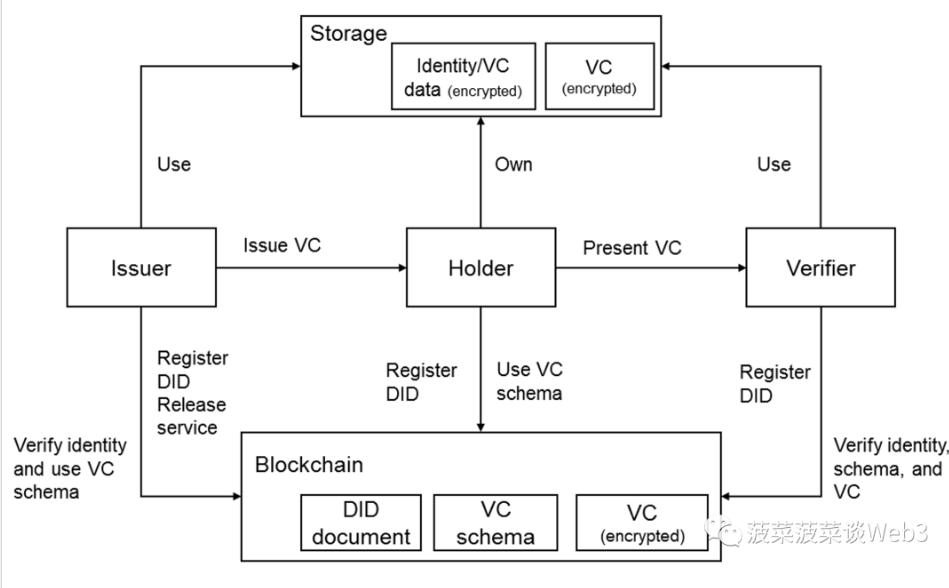
Image Source: https://support.huaweicloud.com/intl/en-us/devg-bcs/bcs_devg_4005.html
On this basis, multiple projects and research teams have integrated privacy protection technologies beyond traditional cryptography into the identity verification system, including the widely recognized Zero Knowledge Proof (ZKP) technology in the Web3 domain. Zero Knowledge Proof is a unique method that allows one party (the prover) to prove to another party (the verifier) that they indeed know a certain piece of information without revealing any specific details about that information.
To illustrate with a simple analogy, suppose Alice wants to prove to Bob that she knows how to restore a specific scrambled state of a Rubik's Cube but does not want to reveal the specific restoration steps. In this case, Alice can use an opaque box to restore the Rubik's Cube without letting Bob see the specific steps. She only needs to take out the restored Rubik's Cube from the box to prove that she knows the restoration technique, while keeping the specific restoration steps a secret. The technical principle of Zero Knowledge Proof is similar, as it can encrypt the true content of the information in the "box" while proving a certain fact.
In the context of digital identity verification, ZKP technology is particularly useful because it allows individuals to prove their information without disclosing private details. Typically, identity verification may require the disclosure of a large amount of personal information, which, once collected and analyzed by multiple parties, could pose a threat to personal privacy. However, systems using ZKP technology, such as zkID developed by zCloak, combined with DID and VC, provide users with richer options for privacy protection.
Through the zkID system, users can flexibly control the amount of information they are willing to share during the verification process after receiving VCs with issuer digital signatures. Users can autonomously choose the granularity of information display, such as Zero Knowledge Proof Disclosure, Digest Disclosure, Selective Disclosure, or Full Disclosure. Especially through Zero Knowledge Proof Disclosure, users can display information under the "minimum knowledge principle," only providing results of "meets the condition" or "does not meet the condition" without revealing any specific private information.
For example, users can prove to relevant institutions that they have a valid visa, loan eligibility, voting rights, or compliance with transaction standards only by displaying locally verified data through Zero Knowledge Proof. Throughout this process, the user's private data is always stored and processed on their local device, without the need to disclose any specific content, ensuring that the data usage rights are completely in the hands of the user.
In summary, in the process of promoting the mass application of real-world asset tokenization, privacy protection and compliance in identity verification have become indispensable cornerstones. By adopting the DID and VC identity verification system based on the W3C standard and integrating Zero Knowledge Proof (ZKP) technology, we can safeguard on-chain identity privacy while meeting compliance requirements. This not only provides implementation guidelines for a "complete legal system" but also represents a potential key link in addressing the gap between on-chain and off-chain, balancing privacy and regulatory requirements.
On-Chain Legal Tender
Blockchain applications are essentially about solving trust issues, and in the business field, 99% of the application scenarios related to trust are related to money[19]. Therefore, for real-world asset tokenization to be widely applied, on-chain legal tender is necessary. The tokenization of on-chain currency itself is actually an application scenario of real-world asset tokenization. Only by introducing central bank digital currencies (CBDC), tokenized deposits, and compliant stablecoins can the full potential of real-world asset tokenization be unleashed.
Currently, the blockchain world lacks a currency trust anchor provided by central banks[20]. Although stablecoins have emerged like mushrooms after rain, filling this vacuum by mapping fiat currencies, the fact that stablecoins have continuously decoupled from prices during market fluctuations in the crypto market indicates that stablecoins cannot replace the role of fiat currencies on the blockchain. Essentially, stablecoins are just "vouchers" for off-chain fiat currencies on the blockchain. Even in the case of stablecoins with fully collateralized assets by the issuing institution, stablecoins may still experience price deviations due to market panic. If the on-chain token is the "essence" of fiat currency, price deviation would not occur.
Compared to the current stablecoin system, the use of tokenized legal tender is not only more convenient and easier to obtain, but its application scenarios are also more significant, providing greater programmable space for financial innovation. First, on-chain legal tender, combined with a consortium chain architecture regulated by national laws, can be directly integrated into our daily payment scenarios. It can seamlessly integrate into our daily lives, whether in salary payments, commercial activities, or other aspects. This means that people can directly obtain on-chain legal tender through their regular activities, bypassing some complex and time-consuming steps in the current crypto system, such as the need to obtain gas fees before using wallets and stablecoins.
In the Bank for International Settlements' (BIS) 2023 Annual Report, in the chapter "Blueprint for the Future Monetary System: Improving the Old, Enabling the New," it is mentioned that tokenization has the potential for revolutionary impact on the existing monetary system, exploring unprecedented opportunities for the current system. This vision describes a new type of financial market infrastructure - the "unified ledger," which integrates central bank digital currencies (CBDC), tokenized deposits, and tokenized debt claims of other financial and physical assets.
The unified ledger has two key advantages. First, it provides a unified platform where a wider range of emergency measures and financial transactions can be seamlessly integrated and automatically executed. This allows transactions to be settled synchronously and in real-time. In contrast to the cryptocurrency world, settlements using central bank currencies ensure the uniqueness of the currency and the finality of payments. Second, by consolidating everything in one place, it will give rise to new or existing contracts (depending on specific circumstances or conditions) that better serve the public interest by addressing issues related to information and incentives[20].
To further help readers understand the importance of on-chain legal tender, the author will further explain and differentiate the definitions of CBDC, tokenized deposits, and legal stablecoins that will be widely used on-chain in the future:
Central Bank Digital Currency (CBDC): A digital form of base currency (Base Money) issued directly by the central bank. Whenever transactions involving CBDC occur, they directly reflect changes on the central bank's balance sheet and can exist in tokenized form on blockchain platforms.
Tokenized Deposits: Deposits are a form of credit money created by commercial banks, and whenever related transactions occur, they directly lead to changes in the balance sheet of commercial banks. Tokenized deposits refer to the tokenized representation on the blockchain.
Legal Stablecoin: In this context, legal stablecoin refers to stablecoins issued by regulated institutions, such as the Australian third-largest bank ANZ's issuance of the Australian dollar stablecoin A$DC. Whenever related transactions occur, since stablecoins are anonymous instruments, they do not reflect changes in the balance sheet of the issuing institution but occur as transfers in different people's wallets.
If you want to further understand the difference between base money and credit money, as well as the process of money creation, you can read another article by the author: "MakerDAO from the Perspective of Money: Understanding the Deep Meaning of Introducing RWA Treasury Assets." Next, let's further explain the application scenarios that on-chain legal tender can bring:
Programmable Digital Currency:
One of the advantages of tokenization is programmability. For tokenized legal tender, programmable currency will open up an imaginative door. For example, the Monetary Authority of Singapore (MAS) released a technical whitepaper on Purpose-Bound Money (PBM) in 2023. This is a digital currency standard that uses "wrapper contracts" to programmatically specify the purpose of currency usage while preserving its fungibility. More details can be found in the PBM whitepaper. The core idea is to use a "wrapper contract" to package and manage generic digital currency, place payment logic in this "wrapper contract," and manage the digital currency within it. Different "wrapper contracts" can be chosen for different application scenarios to constrain and manage the packaged digital currency, achieving the effect of programming the payment process and conditions. However, the packaged digital currencies themselves are uniform, neutral, free, and fungible. Once the conditions are met, the recipient can withdraw the digital currency from the package, restoring the unconditional nature of the digital currency[21].
In simple terms, using PBM technology to program currency allows the currency to be used for specific purposes and automatically revert to a fungible form after meeting the conditions. For example, the government may distribute dedicated funds to the public to stimulate a specific market, such as the peach market, and these funds can only be used to purchase peaches. Alternatively, parents can set up a fund lock for their children to ensure that only a certain amount is unlocked each month to regulate spending. However, this technology may be controversial because while it provides the government with more precise monetary control, it also implies greater regulatory authority, potentially leading to privacy and freedom loss.
Real-World Application Scenarios:
In the past, blockchain technology has encountered numerous obstacles in practical industrial applications, leading to some blockchain projects that do not involve tokens becoming expensive and inefficient database systems. Even blockchain projects with tokens may not fully realize their true potential due to legal regulation and the gap between on-chain and off-chain, with the lack of on-chain legal tender being one of the reasons. We can use an example of RWA to illustrate this.
In the crypto world, some RWA projects attempt to tokenize real-world rental income rights and sell their shares on the blockchain. To achieve this, they face the obstacle of the gap between on-chain and off-chain, such as tenants using off-chain legal tender to pay rent. The project needs to convert the tenant's rent into on-chain stablecoins and then distribute the rental income to the investors holding shares. Not to mention the friction costs involved in converting off-chain currency into on-chain stablecoins, there are also issues of information opacity regarding whether the tenant actually pays the rent, as well as compliance and regulatory issues, such as how to handle disputes or what to do if the project defaults.
However, if it is established within a system with on-chain legal tender and under legal regulation, tenants can naturally use on-chain legal tender to make payments to the corresponding smart contract. The smart contract will automatically distribute the income rights financial product to all shareholders based on their shares. Using token standards like ERC-3525, the issuer can easily package various non-standard rental income rights assets into a standardized financial product, and its transparency allows investors to know if the tenant has actually paid the rent. The issuer can even package many such financial products to form a financial product of financial products.
In summary, the widespread use of on-chain legal tender, especially the extensive application of CBDC, will inject powerful momentum into the mass application of real-world asset tokenization. This not only creates practical scenarios for tokenization technology in our daily lives and various industries but also brings broader development prospects and possibilities, potentially significantly impacting various aspects of people's daily lives.
Oracle and Cross-Chain Protocols
Despite the revolutionary potential of blockchain and tokenization technology, the deterministic operation of blockchain, where each node performs deterministic operations and all nodes get the same output results for the same input data, leads to uncertainty when obtaining and processing external data. This uncertainty can cause inconsistencies between nodes, affecting the consensus process. Therefore, the blockchain itself cannot actively obtain data from the outside world, which is also known as the "oracle problem"[22].
Most potential use cases of smart contracts require the connection of off-chain data and systems. For example, in the financial sector, smart contracts rely on external market price data for execution. In the insurance industry, smart contracts processing claims require judgments based on IoT and network data. Smart contracts in trade finance require access to relevant documents and digital signatures to confirm and execute lending operations. Additionally, many smart contracts require interaction with traditional payment networks for fiat currency transactions. However, a large amount of necessary data is generated off-chain and cannot be directly transmitted to the blockchain[23].
Furthermore, because the blockchain itself is an isolated island, this leads to the fragmentation of users, assets, liquidity, applications, and data. To achieve the mass application of real-world asset tokenization, it is crucial to connect blockchains to each other, reuniting the "islands" into a "continent" to unleash the true potential of blockchain and achieve interoperability among various blockchains. Therefore, whether it is an oracle or a cross-chain bridge, their essence is to facilitate the transmission of information between the blockchain and the outside world, and as a leader in the oracle space, Chainlink will play an extremely critical role in the future mass application of real-world asset tokenization.
In 2023, Chainlink introduced two heavyweight features, Chainlink Function and CCIP. The author believes that they have milestone significance for the mass application of real-world asset tokenization because as more and more financial institutions explore applications involving tokenized assets, they believe in the long-term value of blockchain technology and/or digital assets. However, as central banks or financial institutions in different regions will issue their own CBDC or financial assets on different private/permissioned chains in the future, this will lead to a highly fragmented global blockchain platform, isolating tokenized assets and related services between different blockchains, and these blockchains will not be interoperable. Therefore, this cross-chain communication issue restricts the application of tokenized assets, making them inaccessible and lacking in liquidity, and complicating the integration process for financial institutions[25].
To achieve mass application, people need to be able to freely use these tokenized currencies to purchase assets on other blockchain ecosystems. Although there are many cross-chain protocols in the market, frequent security incidents in the past have made cross-chain protocols a high-risk security area, resulting in countless asset losses. Such "dangerous bridges" are obviously unable to fulfill the mission of reuniting the "islands" into a "continent." Therefore, security in cross-chain protocols has become people's top priority, and the introduction of CCIP by Chainlink may change this landscape and become a widely adopted universal interoperability layer in the future (Note: the author's choice of Chainlink is because of its close cooperation with the traditional financial world).
CCIP is an abstract layer and cross-chain messaging protocol that enables existing infrastructure to connect to blockchains, instructs smart contracts to send arbitrary data, and facilitates token transfers between public and private blockchains. In simple terms, CCIP can link any blockchain together (such as permissioned chains and public chains), solving the interoperability and liquidity fragmentation caused by the blockchain island effect.
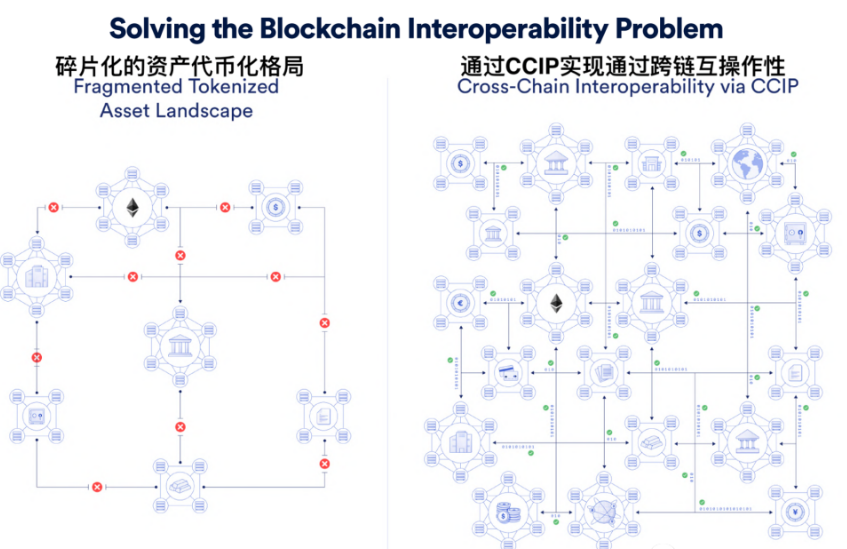
Image Source:
CCIP provides financial institutions with a way to meet customer needs without significant modifications to existing infrastructure[26], allowing them to interact directly with tokenized assets in existing infrastructure. For example, through Swift messages, APIs, mainframes, and other traditional formats, financial institutions can use CCIP to interact with on-chain CBDC on any protocol on any blockchain.
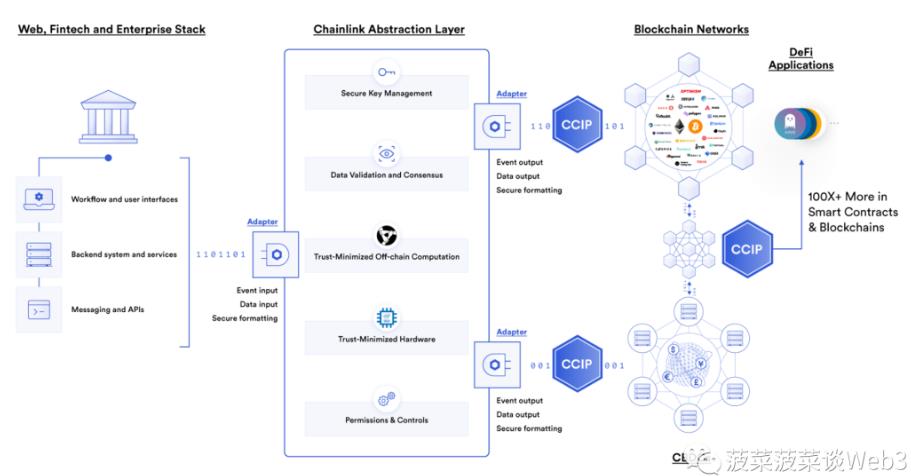
Image Source:
https://blog.chain.link/tokenization-for-capital-markets/#post-title
On August 31, 2023, the Society for Worldwide Interbank Financial Telecommunication (SWIFT) released a report[27], stating that SWIFT, in collaboration with several major financial institutions including ANZ, BNP Paribas, BNY Mellon, Citibank, Clearstream, Euroclear, Lloyd's Banking Group, SIX Digital Exchange, and the Depository Trust & Clearing Corporation (DTCC), conducted an experiment. Using Chainlink's CCIP, the Swift network was securely connected to the Ethereum Sepolia network, achieving full interoperability between source and target chains across multiple jurisdictions and blockchains.
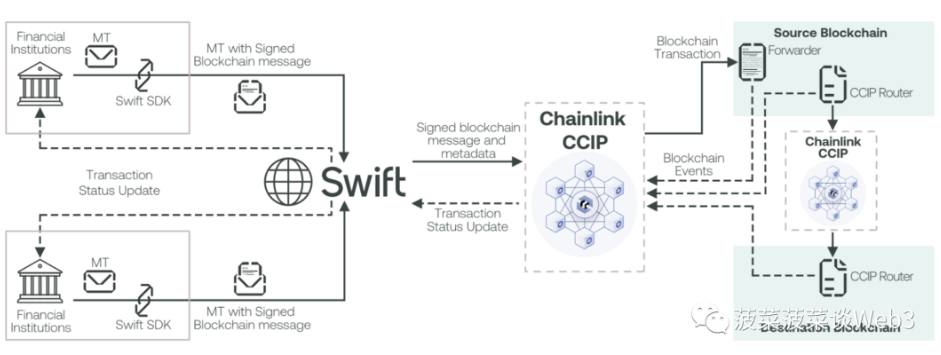
Image Source:
https://blog.chain.link/tokenization-for-capital-markets/#post-title
In addition, Chainlink has partnered with ANZ to participate in a comprehensive case study of CCIP, intending to deploy CCIP in the use of legal stablecoins issued by ANZ to promote institutional participation in tokenized assets. A case study was published[25] demonstrating how financial institutions can use Chainlink CCIP to provide clients with the ability to trade and settle tokenized assets on public and private blockchains. It is foreseeable that in the future, on-chain tokenized assets will exist on public blockchains and regulated permissioned chains operated by financial institutions, and through CCIP, tokenized assets on any blockchain can be connected to achieve interoperability and realize cross-chain connectivity.
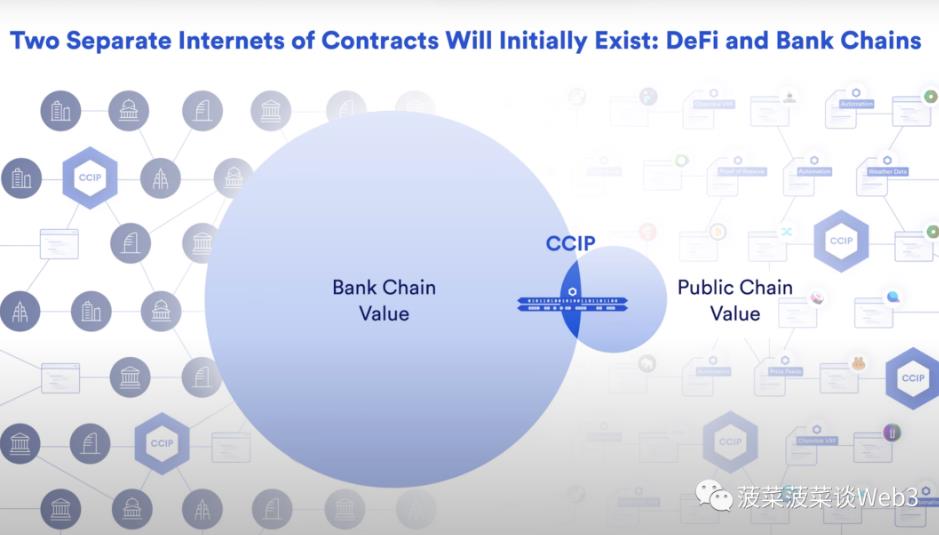
Image Source:
https://www.youtube.com/watch?v=YBfkANJSvJ0&t=167s
In order for blockchain and smart contracts to realize their full potential, it is extremely important to connect with the real world. In the past, the main application scenario for oracles was price feeding services, reliably transmitting real-world price information to the chain through specific data supply chains to provide necessary trigger conditions or parameters for smart contracts. In 2023, with the introduction of Chainlink Function, smart contracts can be linked to any API in the world for conditional triggering or information transmission, and can use Chainlink's decentralized oracle network for customized operations.
Whether it's CCIP or Function, Chainlink's decentralized oracle network, DON, plays an extremely important role, aiming to ensure data security, reliability, and tamper resistance by introducing multiple independent and reliable data provider nodes. This design reduces the risk of single points of failure, making data manipulation more difficult. Therefore, in critical application scenarios, decentralized oracles can provide a higher level of trust and reliability.
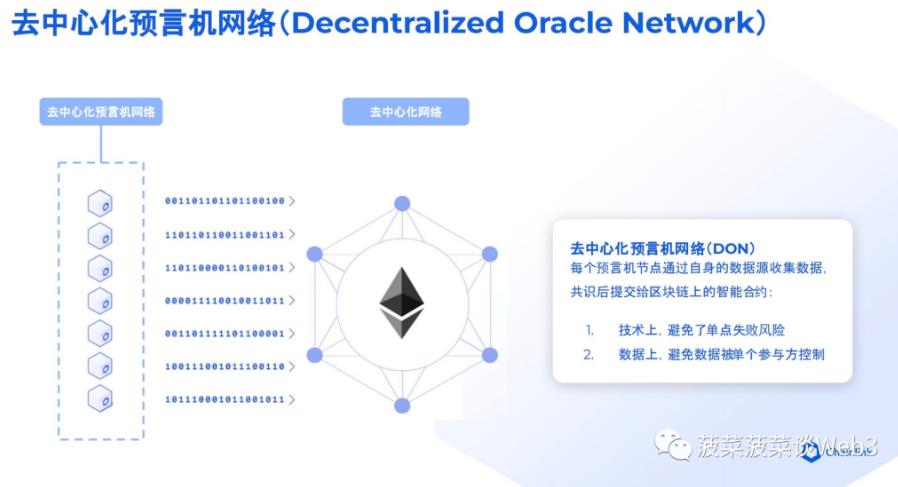
Image Source: https://research.web3caff.com/zh/archives/8102?ref=W3110
Chainlink Function achieves custom operations at the DON level, which can be called decentralized off-chain operations, achieving minimal trust. It combines the characteristics of centralized off-chain and on-chain operations, bridging the gap between centralized off-chain and on-chain operations. According to the official statement, oracle operations enable data transmitted to smart contracts to maintain security, reliability, and tamper resistance while also possessing the advantages of centralized off-chain operations, achieving high performance, low cost, and scalability. Therefore, compared to pure on-chain operations and centralized server operations, Chainlink Function allows smart contracts to achieve functions that were previously difficult to implement or inefficient, providing a great deal of room for imagination.

Image Source: https://research.web3caff.com/zh/archives/8102?ref=W3110
Through Chainlink Function, smart contracts can be linked to any device API in the real world. For example, when there is a risk of DeFi positions being liquidated, smart contracts can automatically send email alerts through Chainlink Function linked to the email API; when there is a flight delay, smart contracts can automatically trigger on-chain insurance contracts through Chainlink Function; by monitoring the status of off-chain assets in real-time and updating the on-chain RWA asset status through Function; or a case combining with the Internet of Things using AWS IoT Core[28], monitoring stablecoin prices with Chainlink Data Feeds and using Chainlink Automation to monitor and report stablecoin prices from Chainlink data sources. If a stablecoin decoupling is detected, it will trigger and call Chainlink Function to send an alert to AWS IoT Core, triggering alerts on IoT devices in the real world.
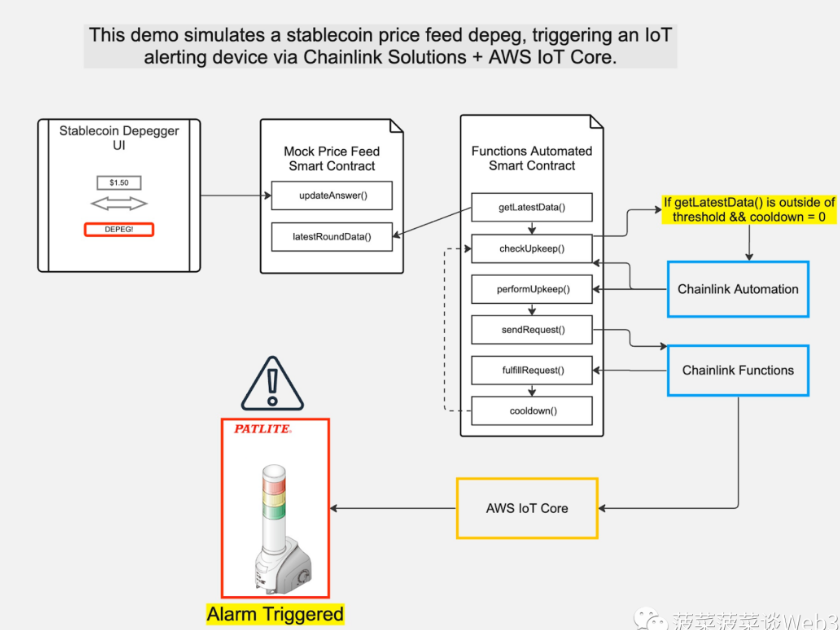
Image Source:
Summary, in the future, with the existence of permissioned chains in different jurisdictions and regulatory systems, cross-chain technology is particularly important for solving the problems of interoperability and liquidity fragmentation. With the emergence of new, more secure cross-chain protocols like Chainlink CCIP and the continuous exploration of the traditional financial world, the foundation has been laid for the future realization of the interconnectedness of tokenized assets across multiple chains, and the continuous improvement of oracle functionality, such as the launch of Chainlink Function, has opened up an imaginative gateway for future integration with the real world.
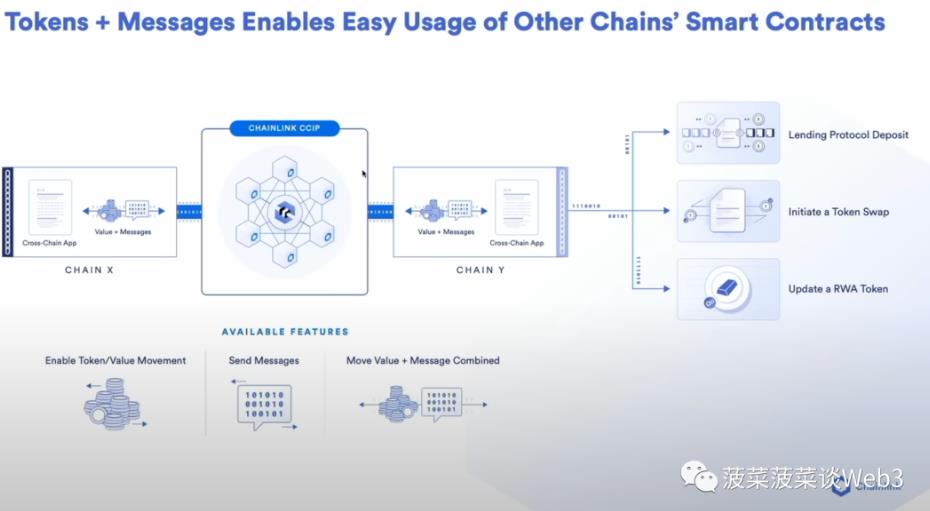
Image Source: https://www.youtube.com/watch?v=8qqy-8Oi8ww&t=24s
Low-Threshold Wallets
As an entry point and pass for entering Web3, wallets not only serve the traditional function of asset management in the Web3 world, but are also essential tools for interacting with blockchains and smart contracts. However, the current high learning curve and frequent asset theft incidents due to hackers have deterred many people, and reducing the threshold for wallet usage is essential to promote mass adoption and ecosystem explosion.
The existing wallet system is mainly divided into two types: EOA (Externally Owned Accounts) and CA (Contract Account). EOA wallets are controlled by a key pair of private and public keys and only have the functions of receiving, holding, sending tokens, and interacting with smart contracts. On the other hand, CA wallets exist in the form of smart contracts and do not have a private key. They are created through the consumption of gas fees and cannot initiate transactions on their own, requiring EOA wallets to call and pay gas fees for transactions.
Both types of wallet accounts have their advantages, limitations, and trade-offs. EOA wallets are limited in programmability and require gas fees for operations, while CA wallets, although offering more functionality possibilities, cannot initiate transactions and require additional costs to create. Simplifying user experience is crucial for both types of wallets.
Account abstraction wallets, such as ERC-4337, are considered the ultimate form for achieving mass adoption of wallets. They combine the advantages of EOA and CA wallets, allowing for programmability while significantly reducing the usage threshold, such as supporting login and wallet usage like Web2, gas payment delegation, social recovery, and aggregated wallets.
However, the mechanism of account abstraction has its complexity, posing challenges for mass adoption. Nevertheless, reducing the user usage threshold remains a top priority. Whether it's account abstraction or other types of wallets, simplifying user experience is crucial. A low-threshold, user-friendly wallet is undoubtedly a key infrastructure for driving blockchain towards mass adoption.
V. Future Outlook
The foreseeable trend is that as traditional finance and governments' attention and recognition of blockchain and tokenization technologies continue to strengthen, and as blockchain infrastructure technology continues to improve, blockchain is moving towards integration with the traditional world and solving real-world pain points in application scenarios, rather than being limited to a "parallel world" separated from the real world.
Despite many people advocating the so-called "blockchain revolution," in the current industry environment, many projects operate under the guise of decentralization but are highly centralized. However, most people do not care, akin to the "elephant in the room." Therefore, the author believes that in the process of applying blockchain to real-world scenarios, the emphasis on decentralization should be weakened, and decentralization should not be forced in inappropriate environments.
Real-world asset tokenization will be the killer application leading blockchain towards a market worth tens of trillions. Its potential may impact the entire human financial and monetary system. By tokenizing real-world assets on blockchain platforms using tokens, it can significantly improve efficiency, reduce costs, operate 24/7, enable programmability, automatic execution, transparency, traceability, composability, privacy protection, empower enterprises, global liquidity, solve trust issues, identity sovereignty, and potential new application scenarios.
Currently, in the Crypto world, the logic of RWA represents a unilateral demand for real-world asset yields. In practice, there are challenges such as regulatory compliance and the gap between on-chain and off-chain. The real potential for tokenization lies in the traditional financial world, where RWA represents a bidirectional logic. The traditional financial world needs blockchain and DeFi technology as a new financial technology tool to empower the traditional financial system and solve its pain points.
To achieve mass adoption of real-world asset tokenization, legal regulatory compliance is a necessary prerequisite. The core assets that need to be tokenized are mostly held by traditional financial institutions, and for institutions, compliance is a necessary prerequisite. It requires a series of legal safeguards to protect investors from fraud and abuse, combat financial crime and cybercrime, safeguard investor privacy, ensure industry participants meet certain minimum standards, and provide recourse mechanisms in case of problems. With legal safeguards in place, the use of permissioned/private chains can meet the demands for effective enforcement of laws and regulations in different jurisdictions.
In order to achieve effective regulation, the concept of "relationship-based identity" that can carry social relationships and credit systems plays a crucial role in the on-chain identity system. This identity system, combined with privacy protection technology, is key to authorizing and managing digital identities under the supervision of governments and regulatory agencies. Within this framework, W3C's DID (Decentralized Identifier) and VC (Verifiable Credential) technologies can play an important role. These standards provide a way for individuals and entities to control their own identity information while ensuring the integrity and verifiability of the information. In the future, the combination with zero-knowledge proof technology also provides new possibilities for strengthening user privacy, security, compliance, and transparency.
In order to meet the regulatory and asset risk management needs of regulatory agencies and financial institutions, the future will be a multi-chain landscape. Therefore, the interoperability between blockchains and the security of information transmission between blockchains are particularly important. With the gradual improvement of new generation cross-chain technologies like Chainlink's CCIP, coupled with its collaboration with traditional financial institutions, we can see the solid foundation being laid for the future multi-chain landscape and the large-scale application of tokenized real-world assets.
For blockchain and smart contracts to be widely used in real-world scenarios, the tokenization of legal tender on the chain, such as CBDC and tokenized deposits, is also indispensable. Unlike the current stablecoin system, stablecoins are not the currency itself, but a kind of on-chain "voucher," and are difficult to be widely used in real commercial activities. For example, in daily shopping or visiting convenience stores, merchants usually do not accept stablecoins as a form of payment. Although some credit cards currently allow users to directly use cryptocurrency for payment, the high fees make it impractical for daily payment activities.
With the popularization of central bank digital currencies (CBDC), the continuous development of tokenization technology, and the reduction of wallet usage thresholds, we can envision a future where people can easily own and manage their tokenized assets, seamlessly completing transactions in daily life using on-chain legal tender through wallets. On-chain legal tender opens up a whole new realm for the promotion of tokenization technology in practical application scenarios, giving it a wider range of applications and practical value.
Currently, many countries around the world are actively promoting legal and regulatory frameworks related to blockchain. At the same time, blockchain infrastructure, such as wallets, cross-chain protocols, oracles, various middleware, are rapidly being improved. Central bank digital currencies (CBDC) are also being continuously implemented, and token standards that can express more complex asset types, such as ERC-3525, are constantly emerging. Coupled with the development of privacy protection technology, especially the continuous development of zero-knowledge proof technology, and the maturing on-chain identity system, it seems that we are on the eve of the large-scale application of blockchain technology.
免责声明:本文章仅代表作者个人观点,不代表本平台的立场和观点。本文章仅供信息分享,不构成对任何人的任何投资建议。用户与作者之间的任何争议,与本平台无关。如网页中刊载的文章或图片涉及侵权,请提供相关的权利证明和身份证明发送邮件到support@aicoin.com,本平台相关工作人员将会进行核查。




